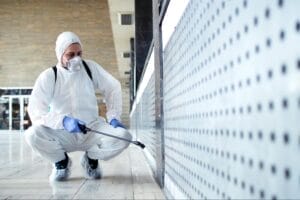Mold growth in crawl spaces is a common issue for many homeowners, often going unnoticed until it becomes a significant problem. Crawl spaces provide the ideal environment for mold to thrive due to the presence of moisture, lack of ventilation, and organic materials that mold feeds on, such as wood and insulation.
Effectively remediating mold in crawl spaces requires thorough inspection, careful planning, and proper execution of remediation techniques to ensure a safe and healthy living environment.
Assessing Mold in Crawl Space
Before initiating mold remediation in a crawl space, it’s crucial to assess the extent of mold contamination and identify the underlying causes of moisture that are contributing to mold growth. Here are key steps to assess mold in crawl spaces:
- Visual Inspection: Conduct a visual inspection of the crawl space, looking for signs of mold growth such as discoloration on surfaces, musty odors, or visible mold colonies.
- Moisture Detection: Use a moisture meter to measure moisture levels in different areas of the crawl space. Focus on identifying sources of moisture, such as plumbing leaks, condensation, or groundwater seepage.
- Professional Assessment: Consider hiring a certified mold inspector or remediation professional to conduct a thorough assessment, especially if the mold contamination is extensive or if there are structural concerns.
Assessing mold in crawl spaces helps determine the scope of remediation needed and allows for targeted interventions to address moisture issues and prevent future mold growth.

Preparation for Remediation
Proper preparation is essential for successful mold remediation in crawl spaces. It involves taking necessary precautions to ensure safety, protect the home’s interior, and facilitate effective cleanup. Here’s how to prepare for mold remediation:
- Safety Gear: Wear personal protective equipment (PPE) including gloves, goggles, and a respirator mask to protect against mold spores and contaminants.
- Clearance: Remove any items stored in the crawl space to provide clear access for remediation activities. This includes furniture, boxes, and other stored materials.
- Tools and Supplies: Gather tools and supplies needed for remediation, such as plastic sheeting, duct tape, HEPA vacuum cleaners, scrub brushes, and approved mold cleaning solutions.
- Ventilation and Lighting: Ensure adequate ventilation and lighting in the crawl space to facilitate safe working conditions and improve visibility during remediation.
Preparing the crawl space for remediation helps minimize disruptions to the home’s interior, enhances safety for workers and occupants, and supports effective cleanup and mold removal.
Steps to Remediate Mold in Crawl Space
Remediating mold in crawl spaces involves a systematic approach to cleaning, disinfecting, and preventing future mold growth. Follow these steps to effectively remediate mold in crawl spaces:
- Inspection and Documentation: Begin by documenting the initial conditions of the crawl space, including photos and notes on visible mold growth, moisture levels, and any structural damage.
- Containment: Create a containment area using plastic sheeting and duct tape to isolate the affected area from the rest of the home. This containment prevents mold spores from spreading to other parts of the house during remediation.
- HEPA Vacuuming: Use a HEPA vacuum cleaner to remove loose mold spores from surfaces and materials in the crawl space. Pay attention to walls, floors, joists, and any exposed insulation.
- Mold Removal: Remove mold-infested materials such as damaged insulation, wood framing, or subflooring. Double-bag these materials in heavy-duty plastic bags for disposal according to local regulations.
- Cleaning and Disinfection: Thoroughly clean all surfaces in the crawl space with a mold-approved cleaner or detergent solution. Scrub visible mold growth from surfaces using a stiff brush and rinse with clean water.
- Drying and Dehumidification: Use fans, dehumidifiers, or natural ventilation to dry out the crawl space thoroughly. Ensure moisture levels are reduced to prevent mold from returning.
Encapsulation: Consider applying a mold-resistant encapsulation product to surfaces and materials in the crawl space to prevent future mold growth. Encapsulation helps create a barrier that seals out moisture and inhibits mold development.
Following these remediation steps systematically ensures comprehensive mold removal and reduces the risk of mold recurrence in crawl spaces. Regular monitoring and maintenance are essential to sustain a mold-free environment.
Preventing Future Mold Growth
Preventing mold recurrence in crawl spaces requires addressing underlying moisture issues and implementing preventive measures. Here’s how to prevent future mold growth:
- Repairing Leaks: Fix plumbing leaks, roof leaks, or foundation cracks that allow water to enter the crawl space.
- Improving Drainage: Ensure proper grading around the home’s foundation to direct water away from the crawl space. Install or maintain gutters, downspouts, and French drains to manage surface water effectively.
- Enhancing Ventilation: Increase airflow in the crawl space by installing vents, fans, or a mechanical ventilation system. Proper ventilation helps reduce humidity levels and promote air circulation.
- Using Vapor Barriers: Install a vapor barrier (polyethylene sheeting) on crawl space floors and walls to prevent moisture intrusion from the ground and minimize condensation.
- Maintaining Indoor Humidity: Monitor and maintain indoor humidity levels below 60% to inhibit mold growth. Use dehumidifiers or air conditioners in humid weather to control moisture indoors.
- Regular Inspections: Conduct regular inspections of the crawl space for signs of water damage, condensation, or mold growth. Address any issues promptly to prevent mold from becoming a recurring problem.
Implementing these preventive measures helps create a dry, well-ventilated crawl space environment that is less susceptible to mold growth and maintains indoor air quality.
How Effective is Fogging for Mold Remediation
Fogging is a popular method used in mold remediation, but its effectiveness can vary depending on the situation. For more detailed information on how to address mold issues, you can read our guide on How Effective is Fogging for Mold Remediation. This resource provides in-depth steps and precautions to ensure thorough mold removal and prevention.




